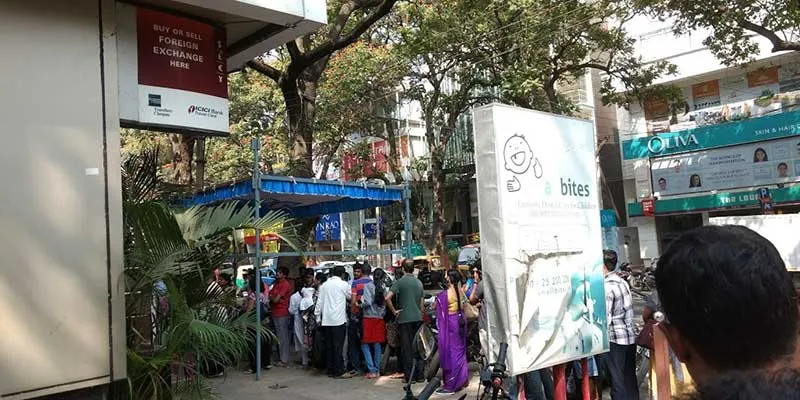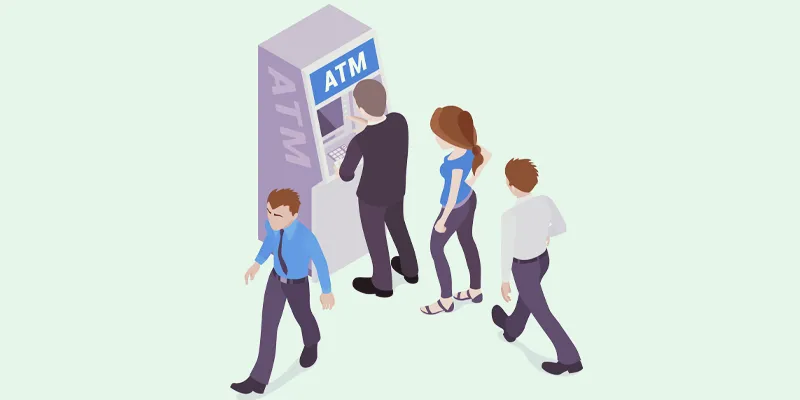Blame the reigning chaos outside ATMs on too many moving parts on the board.
At 2 PM on November 10, Reserve Bank of India’s (RBI) Deputy Governor R Gandhi, called a meeting of a motley crowd that comprised of original equipment manufacturers, cash logistic firms (CLF), and managed service players.
Unlike some high-profile, dial-a-quote bankers, it’s these behind-the-scene folks who collectively make up the automated teller machine (ATM) mart’s big joint family – they either make till-boxes, load cash into them, or deploy and manage them on behalf of banks so that they hum every time you swipe your plastic on it.

At the end of the two-hour long interaction, Gandhi’s message was in a nutshell: evacuate the old lot of cash lying in ATMs – in all 2,20,000 of them across the country -- and load the new series of Rs 500, Rs 1000, and Rs 2000 notes with the least amount of fuss.
Navroze Dastur, Managing Director of NCR Corporation (the world’s biggest manufacturer of ATMs) for India and South-Asia, has also turned an insomniac. He says,
“It just proves that cash can’t be dethroned all that easily in a country like ours. Atlanta (NCR’s headquarters) is keeping a close eye on the developments here.”
In the days since, the world’s biggest ever “reset” of the “cassettes” that hold cash within ATMs is on in full swing. Think of “cassettes” as trays which must be reconfigured to make room for the heavy loading of fresh notes into ATMs after Prime Minister Narendra Modi’s move on November 8 to go in for a surgical strike on black money.
According to says Suneel Aiyer, CEO-Writer Safeguard,
“Nowhere on this planet has such a huge reset (of ATM cassettes) been done. You have no idea of the sheer logistics behind all this. I have not had a good night’s sleep for the last three days.”
It’s a chaos
But ATM “reset” is just one of the issues the authorities have to grapple with. YourStory has gathered that there is complete chaos at branches as bank officials expect cash-loaders to stand in queues with customers for two to three hours as their immediate priority is the retail audience. You also have a shortage of cash-counting machines at branches – typically these are used to count smaller amounts, not the huge volumes, which are now hitting branches.
At ATMs, the scene is not very different. You need three officials to recalibrate a machine – two from the CLF and one from the bank as part of the drill that involves opening the cash-box and putting in the new codes. To start with, reports of adequate cash being available to re-load ATMs is a bit misplaced – there’s not enough by way of the right denomination to feed all 2,20,000 ATMs in the country. And then a large amount of cash is being used for over-the-counter operations at bank branches. You also have many drawing down cash by using multiple debit cards – net result cash runs out in a jiffy.

It takes about 25 minutes to recalibrate an ATM; in the bigger metros and cities, you have ATMs cheek by jowl. But get out of these locations and the plot changes – ATMs are spread out wide and the sheer effort required to move around with all the cash makes it back-breaking work.
At the backend, some officials speak of a communication gap – South Block was briefed by Mint Road on the process involved; inputs from senior bankers would have been taken. But the nature of ATM business is that it’s run by CLFs and managed service players. Few banks in the country run an ATM network with their people on the job; it's erroneous to think that a bank whose signage is in front of an ATM takes care of it.
These back-end players were called in for a meeting at RBI almost 15 hours after the announcement last Tuesday and by the time they got into action, valuable time had been lost.
What’s complicated matters is usually ATMs are fed cash based on the residual amount left in them -- when the cash-balance in a unit falls to about 25 percent, you have an electronic trigger that signals it has to be loaded up again. But what we have by way of departure from this practice is that all 2,20,000 ATMs have to be fed afresh. That makes the logistics unwieldy. After all, there are only that many cash-vans to move these sums about; it’s not particularly safe to do so at night in some locations. And then, people who are at the job also need to get some sleep!
While the current “reset” in the ATM world is a one-off, ponder over this – just how much cash needs to be “fed” into ATMs at the systemic level?
Don’t try to work it out in your head; we will tell you just how much.
Each till-box needs to be “fed” cash four times a month; each “belly-fill” ranges between Rs 10 lakh and Rs 15 lakh. Now at end-September 2016, we had an installed base of 2,20,000 ATMs; so when taken at the lower end (of the amounts being “fed”), it adds up annually to a small sum of Rs 10,56,000 crore. Divide this by 365 (use a calculator!) to know how much cash goes into ATMs on a daily basis.
If you still think that the mess will be sorted out in three weeks, good luck to you.







